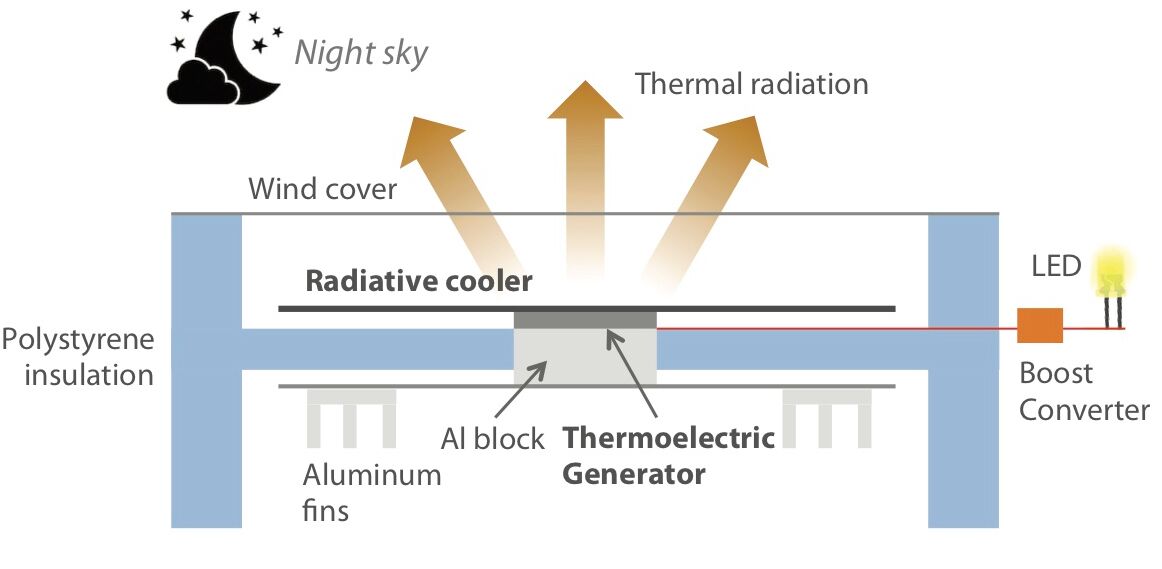Why not make a standardized window set in which this effect is tapped to feed charging energy to a cell phone socket. Most cell phones are recharged at night and simply integrating the prime charging time is justified.
Such a product manufactured as part of a sealed window unit should sell globally and even directly through cell phone retailers.
Where grid power does not exist this very useful, but finally tapping our windows will work in even the developed world.
.
This $30 Device Turns the Cold of Outer Space Into Renewable Energy
“It literally is generating visible light out of the darkness of the sky. This is not even paraphrasing, this is exactly what it is." By Maddie Bender Sep 12 2019, 11:42am
The sun can be a powerful source of renewable energy, but so can the night sky. Now, a team of scientists have created a device that turns the cold of space into enough electricity to power an LED light.
As described in a paper published on Thursday in the journal Joule, the device is based off of a thermoelectric generator that creates electricity from the difference in temperature between a "hot side" and a "cold side." The researchers—UCLA scientist Aaswath Raman, and Stanford scientists Wei Li and Shanhui Fan—decided to take this idea one step further and use the ambient environment of Earth as a heat source and the cold of outer space as one gigantic cold sink.
The prototype consists of four stilts supporting two plates sandwiched between a thermoelectric generator. One plate is aimed at the ground, the other at the sky. The downward-facing plate draws heat from the air around it, while the upward-facing plate is paired with an aluminum disk painted black. The disk acts as an emitter that radiates heat into space through Earth’s atmosphere, cooling the plate to below ambient temperature.
This effect is known as radiative cooling, Raman said, and scientists have known about the phenomenon for years. It's the reason why a window can be frosty in the morning even when last night’s temperature wasn’t below freezing, and, as Raman explained in a 2018 TED Talk, it's the reason ancient Persians were able to make and store ice in the desert.
“This is honestly an experiment a high school student could do, and probably will do at some point,” Raman said. “The simplicity is what makes it compelling.”
In a December 2017 test of a prototype, the team recorded a temperature difference between the two plates of up to 2 degrees Celsius on a clear night. A thermoelectric generator attached to the device was able to convert this temperature difference into just enough energy to passively power an LED bulb through the night at about 10 percent of its possible brightness.
“The big caveat with this work that I’d like to state upfront…is that the amount of power we’re generating is very small,” Raman said.
Still, he added, with more engineering the work could be applied in useful ways. Streetlights passively powered by electricity from radiative cooling would not have to have their batteries replaced, and people could charge their cell phones off the grid. Raman said the technology won't single-handedly solve the climate crisis, but it could play a role in increasing access to energy.

A diagram of the setup. Image: Raman et al.
For Raman, the reality that nearly 1 billion people worldwide live without electricity underscored the need for a cheap, nontraditional lighting technology. In contrast to solar power, which collects energy during the day and stores it in a battery, this device produces energy in the form of electricity for 24 hours a day and does not need a battery.
The cost of the materials totaled less than $30 USD, in part because the researchers wanted to see how cheaply the device could be made. They used a store-bought thermoelectric modulator, sheet metal, Styrofoam, and Saran Wrap. Buying in bulk would lower these costs, but future refinement of the product may increase others, Raman said.
Raman said he and co-author Fan began collaborating on radiative cooling in 2012, but this idea was somewhat of a side project. The two are co-founders of SkyCool Systems, a company that makes panels that use radiative cooling to create more eco-friendly cooling and air conditioning.
This study, however, makes the case that the coldness of outer space should also be treated seriously as a thermodynamic resource for electricity generation, said Fan.
“It literally is generating visible light out of the darkness of the sky. This is not even paraphrasing, this is exactly what it is,“ he said.

No comments:
Post a Comment